Rudolf Jenny, PhD, offers an introduction to this interesting genus of Neotropical Orchids.
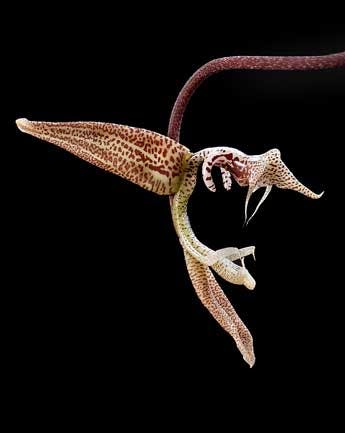
Gongora grossa, which was described in the Gardeners' Chronicle in 1877, is native to Ecuador, Colombia and Venezuela. Photo by Greg Allikas.
The history of the first-known Gongora species — Gongora quinquenervis Ruiz and Pavon — coincides with its first truly scientific treatment in Flora of Peru by Hipolito Ruiz Lopez, Antonio Pavon y Chimenez and Joseph Dombey during the last quarter of the 18th century. The incentive to start the scientific exploration of the territories that belonged to the Spanish properties in South America in those days (Peru and large parts of what are now Bolivia, Chile, Argentina and Ecuador) did not come from the Spaniards themselves, but from the French. Indeed, it was A.R.J. Turgot, prime minister of Louis XVI, who, in 1775, decided to launch a scientific expedition to Peru to replace the lost collections of Joseph de Jussieu. De Jussieu himself recommended Joseph Dombey, a botanist and medical doctor who had been one of Joseph de Jussieu's brother Bernard's students, as tentative expedition leader. However, Spain, at the time ruled by Charles III, uncle of Louis XVI, would only agree to the expedition on a number of special conditions. Dombey was to be accompanied by two Spanish scientists, and the overall command had to remain in Spanish hands. Dombey had to agree to turn all herbarium materials that were to be collected during the expedition to the botanical gardens in Madrid. Of each collected object, three herbarium specimens had to be made. Dombey was to receive one of them, but only after examination in Madrid. Furthermore, he had to agree to supplement those materials of which only one herbarium specimen could be made by botanical drawings and descriptions, which, of course, had to be deposited in Madrid.
The Spanish government chose two pharmacists, Ruiz and Pavon, neither of whom had any training in botany, and two artists to accompany Dombey. Ruiz, junior to Dombey by 12 years was appointed commander. Upon arrival in Peru, Dombey had to obtain and pay for his equipment himself, whereas Ruiz and Pavon got the full support of the Spanish administration. Furthermore, as the Spanish artists refused to make any drawing for Dombey, he had no choice but to illustrate all his materials himself.
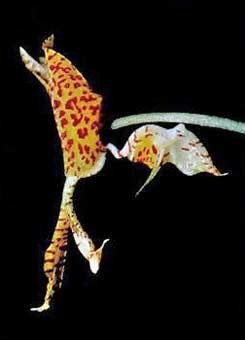
Rudolf Jenny described Gongora sphaerica in his book Monograph of the Genus Gongora Ruiz& Pavon, which was published in 1993. This species is native to Colombia. Photo by R. Jenny.
The Journey Begins
The expedition left Europe in October 1777 and reached Lima in April 1778. In the same year, Dombey sent a first, small collection to Europe, and in March, 1779, a large collection followed. The ship transporting this large collection, however, was captured by the English (at the time at war with France and Spain) and the materials were auctioned off in Lisbon. Spanish representatives purchased the entire collection as well as a number of Dombey's personal belongings. Originally, the expedition was to last four years, but the continuing war made a scheduled return impossible. Finally, on April 4, 1784, Dombey left Peru by himself and, after a delay of several months in Rio de Janeiro, reached Cadiz on February 22, 1785, with his part of the collections.
The materials that were to be turned over to the Spaniards remained in Lima and were shipped together with the collections of Ruiz and Pavon to Spain in 1785. The ship carrying these materials was lost off Portugal with all collections on board. The only materials from the expedition that were left, therefore, were what was brought home by Dombey him-self. That material was retained by the Spaniards. At the end, Dombey obtained only one third of "his" materials and had to agree to publish nothing, nor to de-scribe any plants before the return of Ruiz and Pavon. Of course, the Spaniards carefully copied all Dombey's notes and descriptions. At last, Dombey reached Paris with the poor remnants of his collection on October 13, 1785.
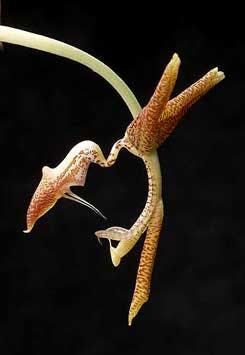
Native to Colombia, Gongora gratulabunda bears 10 to 12 flowers along its 20-inch-long inflorescences at wide intervals. Photo by Greg Allikas
Gongora Enters the Picture
Ruiz and Pavon stayed in Peru, and in 1785 they were collecting around Huanuco. Again, catastrophe struck and the collections of several months as well as extensive diaries and the great majority of the plant descriptions were lost to a fire at the base camp. The materials of Gongora quinqueneirvis collected in 1779 were part of the shipment that accompanied Dombey on his voyage home. After about nine years in Peru and Chile, Ruiz and Pavon left Peru on April 1, 1787 and reached Spain in the spring of 1788.
Five more years would pass before Ruiz and Pavon had a chance to do any extensive work on the plants they and Dombey had collected. For that reason, they first published a single volume entitled Flora Peruvianae, et Chilensis Prodromus in October 1794. The distribu-tion of that volume, however, was limited. The "complete" Flora Peruviana, et Chilensis followed in 1798 (volume 1), 1799 (volume 2) and 1802 (volume 3). Although the flora was intended to com-prise eight volumes, only three were pub-lished by Ruiz and Pavon. Two more vol-umes were published by other authors at a much later date (volume 4 in 1957 and volume 5 in 1959).
All orchids collected by the expedition were first published as genera in the 1794 Prodromus and later (1798) in Ruiz and Pavon's Systema Vegetabilium Florae Peruvianae et Chilensis. In the flora, no orchids were included.
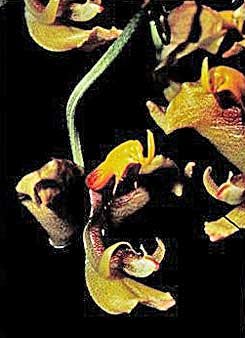
Gongora sanderiana is easy to identify, due to its broad, round hypochile when seen from above. Photo by R. Jenny.
The fact that the majority of this publication is based on the collections, descriptions and notes of Dombey and not on any material definitely originating from Ruiz and Pavon is often overlooked and neglected. Dombey did not get credit on the title page and his name is merely mentioned in the preface. Ruiz died in 1815 and Pavon in 1844. Parts of the herbarium containing the collections of the expedition to Peru and Chile were obtained by Lambert. They are now in the collections of the British Museum of Natural History in London. Another part, containing the type material of G. quinquenervis, remained in Madrid. The three herbarium specimens related to that species that are now in Madrid contain only vegetative parts of the plants, and inflorescences with seed capsules, but no flowers. The drawing of G. quinquenervis, published by Ruiz and Pavon in their Systema Vegetabilium, however, is detailed enough to allow for a clear classification of the taxon.
Ruiz and Pavon indicated the type location as being Pozuzo (Peru) and the flowering time as September and October. Whether the plants were found by Ruiz and Pavon, Dombey or all three collectors together, will most probably remain uncertain. However, as the herbarium specimens of G. quinquenervis were part of the collections brought home by Dombey, it is logical to assume that he was at least present at the time of discovery. The original publication of the genus Gongora appeared in the Prodromus of 1794 with a drawing of the flowers of G. quinquenervis (t. 25) but without any description of these parts. The valid description of the type species of the genus Gongora, Gongora quinquenervis - followed in the Systema, which was an addendum to the first volume of the flora. It is, indeed, somewhat confusing that the authors apparently published what they considered to be the important parts of the flora in their 1794 Prodromus, which, as stated above, had but a limited distribution, and that the publication of the actual flora did not begin before 1798. The generic names published in the Prodromus are, however, considered to be valid and effective and, therefore, have to be cited accordingly. The genus Gongora was named in honor of Don Antonio Caballero y Gongora.
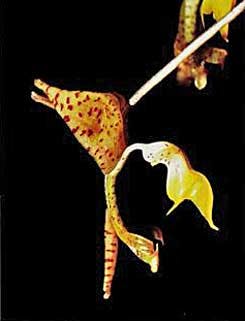
Gongora galeottiana is named after Henry Guillaume Galeotti, a Belgian botanist and former director of the Botanical Gardens in Brussels. Collected in Mexico, this species occurs at elevations between 1,640 and 3,940 feet above sea level. Photo by R. Jenny.
The Story Continues
In 1830, a plant originating from Mexico came into flower in the collection of Conrad Loddiges (England). The plant was described as Maxillaria galeata by John Lindley in 1831. In 1833, Lindley created the genus Acropera and redescribed his Maxillaria galeata in honor of Loddiges as Acropera loddigesii. In 1858, the genus Acropera was included in Ruiz and Pavon's genus Gongora by the younger Reichenbach, who renamed the species as Gongora galeata (Lindl.) Reichb.f. The name "Acropera" has been retained as a subgenus of Gongora, comprising six species, all originating from Central America. Of this subgenus, G. galeata is the type species, and at the same time the species most common in cultivation. It is considered to be a true "beginner's plant."
The Genus Gongora
The Gongora, as far as systematics is concerned, belongs in the subtribe Stanhopeinae Bentham (according to Dressler's classification) or Gongorinae (according to Schlechter's system) together with about 20 other closely related genera such as Coryanthes Hooker, Stanhopea Frost ex Hooker, Sievekingia Reichb.f. and Cirrhaea Lindley. It now comprises about 55 species, subspecies and varieties.
The distribution of the genus Gongora is limited to the Neotropics (Central and South America). Two species (Gongora atropurpurea and Gongora maculata ) are found on Trinidad (which is floristically similar to South America). No species are found on any of the other Caribbean Islands. The distribution in South America is on both sides of the Andes from Colombia to Ecuador and on the eastern slopes as far south as Peru and Bolivia. The floras of Venezuela, the Guyanas and Brazil are poor in respect to gongoras.
The habit of the Gongora species, and especially the fact that the pendent inflorescences originate from the base of the pseudobulbs, indicates that they all are true epiphytes.
The genus is furthermore characterized by a complex pollination system. They are pollinated by male solitary bees of the Euglossinae family only (a feature they share with the stanhopeas.) The bees are attracted by a strong floral fragrance, and pollination occurs when the insect attempts to reach the source of the fragrance inside the flower structure. As the composition of the fragrance differs from one species to another, it may be assumed that each fragrance is intended to attract few or even one single kind of bee, indicating a more or less clear-cut reproductive isolation. Specific studies, however, have revealed quite distinct qualitative as well as quantitative variation in the composition of the fragrance of plants within one single population. The fragrance also varies in respect to the time of the day and the relative age of the flowers. These results show that fragrance analysis, although possibly a useful taxonomic tool, cannot replace "classic" taxonomy and should not be used isolated from other criteria. Indeed, a difference in fragrance does not necessarily indicate a difference in species.
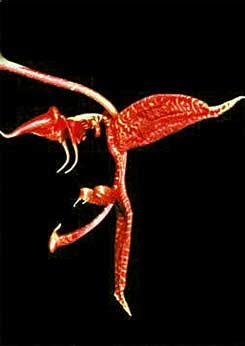
Gongora pseudoatropurpurea is among those species from which growers can choose when selecting a plant to cultivate. Photo by R. Jenny.
Growing the Plants
The species of the genus Gongora are not exceptionally rare in cultivation, notwithstanding the fact that their flowers last just a few days and that the plants do require some extra space. Many species of this genus show extensive morphological affinities and are, therefore, often difficult to tell apart, thus just as often causing mislabeling in the collections. Most Gongora species are easy to cultivate and quickly grow into large and showy plants. They do best when mounted on blocks of cork or tree fern or grown in hanging baskets. The important criteria for the successful growing of Gongoras are a warm environment and constant high humidity with, however, continuous ventilation. All species of this genus (and here they do not differ from most other orchids) are "allergic" to stagnating moisture, and are, under adverse conditions, readily targeted by fungi. Although Gongora species can also be found in areas with temporary dry seasons, none of the species really needs a distinct resting period in cultivation, thus, the watering schedule can be continued throughout the year. The gongoras, however, require regular applications of fertilizer. Large specimens should be divided, preferably when the young growths are a few inches in size, but still without roots. Each division should have at least three backbulbs.
Gongoras offer something for every orchid grower, although those with greenhouses are more likely to have the space to develop impressive specimens of this New World genus of orchids.
Rudolf Jenny, PhD, is author of Monograph of the Genus Gongora Ruiz and Pavon (BK 6013), published in 1993 and The Stanhopea Book published in 2010 — Moosweg 9, Ch-3112 Allmendingen, Switzerland.
Gongora Species in Cultivation
— Compiled by Rudolf Jenny
- Gongora aceras Dressier
- Gongora amparoana Schlechter
- Gongora armeniaca (Lindley) Rchb.f.
- Gongora aromatica Rchb.f.
- Gongora atropurpurea Hooker
- Gongora bufonia Lindley
- Gongora cassidea Rchb.f.
- Gongora charontis Rchb.f.
- Gongora chocoensis Jenny
- Gongora claviodora Dressier
- Gongora colombiana Jenny
- Gongora cruciformis Whitten and Bennett
- Gongora dressleri Jenny
- Gongora ecornuta Jenny
- Gongora escobariana Whitten
- Gongora fulva Lindley
- Gongora galeata (Lindley) Rchb.f.
- Gongora galeottiana Richard and Galeotti
- Gongora gibba Dressier
- Gongora gracilis Jenny
- Gongora gratulabunda Rchb.f.
- Gongora grossa Rchb.f.
- Gongora hirtzii Dodson, Williams and Whitten
- Gongora histrionica Rchb.f.
- Gongora horichiana Fowlie
- Gongora ilense Whitten and Jenny
- Gongora irmgardiae Jenny
- Gongora latisepala Rolfe
- Gongora leucochila Lemaire
- Gongora maculata Lindley
- Gongora minax Rchb.f.
- Gongora nigrita Lindley
- Gongora odoratissima Lemaire
- Gongora pleiochroma Rchb.f.
- Gongora portentosa Linden and Rchb.f.
- Gongora pseudoatropurpurea Jenny
- Gongora quinquenervis Ruiz and Pavon
- Gongora rufescens Jenny
- Gongora saccata Rchb.f.
- Gongora sanderiana Kraenzlin
- Gongora similis Rchb.f.
- Gongora sphaerica Jenny
- Gongora superflua Rchb.f.
- Gongora tridentata Whitten
- Gongora truncata Lindley
- Gongora unicolor Schlechter
Republished from ORCHIDS magazine, November 1996








